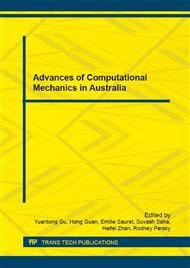p.1
p.7
p.12
p.18
p.23
p.30
p.36
p.42
Effect of Slit Inclusions in Drag Reduction of Flow over Cylinders
Abstract:
The flow over bluff bodies is separated compared to the flow over streamlined bodies. The investigation of the fluid flow over a cylinder with a streamwise slit has received little attention in the past, however there is some experimental evidence that show for turbulent regime it reduces the drag coefficient. This work helps in understanding the fluid flow over such cylinders in the laminar regime. As the width of the slit increases the drag coefficient keeps on reducing resulting in a narrower wake as compared to what is expected for flow over a cylinder. In this work we have used two different approaches in modelling a 2D flow for Re=10 to compare the results for CFD using finite volume method (ANSYS FLUENTTM) and Lattice Boltzmann methods. In all cases cylinders of circular cross section have been considered while slit width changing from 10% to 40% of the cylinder diameter. . It will be shown that drag coefficient decreases as the slit ratio increases. The effect of slit size on drag reduction is studied and discussed in detail in the paper. We have also made comparison of the results obtained from Lattice Boltzmann and finite volume methods.
Info:
Periodical:
Pages:
18-22
Citation:
Online since:
July 2016
Authors:
Price:
Сopyright:
© 2016 Trans Tech Publications Ltd. All Rights Reserved
Share:
Citation:


